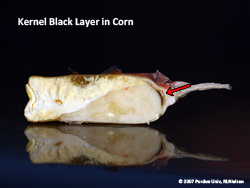16 September 2019
URL: http://www.kingcorn.org/news/timeless/RStagePrediction.html
Predicting Corn Grain Maturity Dates for Delayed Plantings
R.L. (Bob) Nielsen
Agronomy Dept., Purdue Univ.
West Lafayette, IN 47907-2054
Email address: rnielsen at purdue.edu
Twitter: @PurdueCornGuy
![]() elayed planting of corn in the upper Midwest often increases the risk that the grain will not mature prior to a killing fall freeze. Physiological maturity occurs near the time the so-called "black layer" develops at the tips of the kernels where they connect to the cob (Nielsen, 2019a). Kernel dry weight reaches its maximum at this point and the grain is generally considered to be safe from the effects of a subsequent killing fall freeze.
elayed planting of corn in the upper Midwest often increases the risk that the grain will not mature prior to a killing fall freeze. Physiological maturity occurs near the time the so-called "black layer" develops at the tips of the kernels where they connect to the cob (Nielsen, 2019a). Kernel dry weight reaches its maximum at this point and the grain is generally considered to be safe from the effects of a subsequent killing fall freeze.
Under "normal" planting dates and growing conditions, the calendar time from individual grain fill stages to physiological maturity is similar across a wide geographical area of the U.S. Midwest. Physiological maturity (kernel black layer) for adapted corn hybrids occurs approximately 65 days after silking in the central Corn Belt (Abendroth et al., 2011; Brown, 1999; Neild & Newman, 1990) and 55 to 60 days after silking in the northern Corn Belt (Lauer, 2016). Earlier maturity hybrids not only reach silking in fewer days after planting, but will also reach black layer in fewer days after silking (Brown, 1999; Nielsen et al., 2002).
The nagging question that worries farmers during the "dog days" of late summer following a delayed planting season is whether there are enough days left in the growing season for the crop to mature safely. The answer to that question depends on the current growth stage of the late-planted crop, the relative maturity of the hybrid planted in the field (Nielsen, 2012), the number of heat units (GDDs) yet to be received, and of course the actual date of the pending killing fall freeze.
Based on field research conducted in Indiana and Ohio (Brown, 1999), we know that corn hybrids typically mature with fewer accumulated heat units when planted late compared to planting on "normal" dates. This knowledge provides the basis for our hybrid maturity recommendations to farmers faced with late plantings (Nielsen, 2019b; Nielsen & Thomison, 2003).
That same research provided insight into both the calendar and thermal times typically required for grain at various stages of development to reach physiological maturity (kernel black layer, R6). The research was conducted at two locations in Indiana (westcentral and southeast) and two locations in Ohio (northwest and southwest) with three hybrids representing 97, 105, and 111 "day" relative maturities planted in early May, late May, and early June. The calendar and thermal times from silking to black layer for the three hybrid maturities are provided in Tables 1 - 3 that follow.
While there were slightly different responses among the four locations of the trial, there did not seem to be a consistent north / south relationship. Consequently, I believe growers can use the results summarized in the following tables to "guesstimate" the number of calendar days or heat units necessary for a late-planted field at a given grain fill stage to mature safely prior to that killing fall freeze .



Related Reading
Abendroth, Lori J., Roger W. Elmore, Matthew J. Boyer, & Stephanie K. Marlay. 2011. Corn Growth and Development. Iowa State Univ. Extension publication PMR1009. Purchase online at https://store.extension.iastate.edu/product/6065. [URL accessed Sep 2019].
Brown, Greg A. 1999. Influence of Delayed Planting on Growing Degree Day Requirements of Corn (Zea mays L.) Hybrids During Grain Fill and Maturation. M.S. Thesis, Purdue University.
Lauer, Joe. 2016. Corn Development. Univ. of Wisconsin. http://corn.agronomy.wisc.edu/Management/L011.aspx [URL accessed Sep 2019].
Neild, Ralph & Jim Newman. 1990. Growing Season Characteristics and Requirements in the Corn Belt. Purdue Extension Pub. NCH-40. http://www.extension.purdue.edu/extmedia/NCH/NCH-40.html [URL accessed Sep 2019].
Nielsen, RL (Bob). 2012. Interpreting Corn Hybrid Maturity Ratings. Corny News Network, Purdue Extension. http://www.kingcorn.org/news/timeless/HybridMaturity.html [URL accessed Sep 2019].
Nielsen, R.L. (Bob). 2017. Heat Unit Concepts Related to Corn Development. Corny News Network, Purdue Extension. http://www.kingcorn.org/news/timeless/HeatUnits.html [URL accessed Sep 2019].
Nielsen, RL (Bob). 2019a. Grain Fill Stages in Corn. Corny News Network, Purdue Extension. http://www.kingcorn.org/news/timeless/GrainFill.html [URL accessed Sep 2019].
Nielsen, RL (Bob). 2019b. Hybrid Maturity Decisions for Delayed Planting. Corny News Network, Purdue Extension. http://www.kingcorn.org/news/timeless/HybridMaturityDelayedPlant.html [URL accessed Sep 2019].
Nielsen, R.L. (Bob) and Peter Thomison. 2003. Delayed Planting & Hybrid Maturity Decisions. Purdue Univ. Cooperative Extension Publication AY-312-W. https://www.agry.purdue.edu/ext/corn/pubs/AY-312-W.pdf [URL accessed Sep 2019].
Nielsen, Robert L., Peter R. Thomison, Gregory A. Brown, Anthony L. Halter, Jason Wells, and Kirby L. Wuethrich. 2002. Delayed Planting Effects on Flowering and Grain Maturation of Dent Corn. Agron. J. 94:549-558.
